The extensive salt marshes on the Outer Banks of Carolina offer ideal conditions for unravelling the mysteries of sea level change during past centuries. Here is a short report from our field work there – plus some comments on strange North Carolina politics as well as two related new papers published today in Nature Climate Change.
The Outer Banks of Carolina are particularly vulnerable to coastal erosion and sea-level rise, partly because the land is subsiding and the banks are naturally moving landward. On the ocean front, land is continually being lost.
At 11.20 AM we get a walky-talky call from the research vessel Stanley Riggs which anchors a bit offshore from us: a few meters behind us is a shark in the water they say. They’ve been observing it through their binoculars. We haven’t noticed a thing and turn around, but only the student Ray catches a glimpse of the fin before it disappears. We’re standing on a bit of peat surrounded on three sides by water, drilling a core. Sharks don’t bother us – but the people on the ship are worried about our divers who plan to go in the water shortly. We don’t see the shark again – only little snakes elegantly gliding past through the water, heads above the surface, and some crabs, a popular local delicacy.
R/V Stanley Riggs lands our team at Sand Point.
To us as onshore crew, alligators would be far more interesting than sharks. Last week, not far from one of the study sites a man was injured by an alligator. My colleagues reassure me: alligators are nothing to worry about, as long as you can run faster than the slowest person in the group. But everything looks as peaceful as it can be now. The sun glitters on the lagoon, every now and then a group of pelicans patrols over our heads and convective clouds are billowing near the horizon. Sometimes we hear thunder rolling in the distance, but it stays dry all day. What a contrast to the previous day! A cold wind and constant rain bothered us and a series of technical failures meant that we did not even bring a useable core home. A dozen people worked a whole day in vain. (No hint that day of the fact that this May was the warmest on record in the Northern Hemisphere!)
The day I arrived on the Outer Banks I’d been greeted with news of a 50:50 chance of a tropical storm developing offshore. The same evening the first tropical storm of the season was called by the National Hurricane Center: Alberto. In mid-May – the hurricane season officially only starts in June (it turned out to be only the third May on record with two tropical storms in the Atlantic). The Outer Banks are very exposed. Several times in the last decades a hurricane caused a break in the barrier island and washed away the only road connection to the mainland. Luckily, Alberto turned offshore and passed far out at sea without bothering us.
Andy Kemp (on right) with students Ray and Hanna.
We’re here because of the several metres thick peat layer which has accumulated during the past millennia behind the Outer Banks. The land here is still sinking since the end of the last Ice Age, because it is located on the glacial forebulge: a zone around the edges of the glacial ice sheets that was pushed up when the ice load was pushing down adjacent lands. So instead of getting post-glacial uplift it suffers from post-glacial subsidence. The subsidence has led to a continuous sea-level rise relative to the land of around one millimetre per year. The salt marsh is able to keep up with this rise by accumulating sediments and building up peat, about a metre per millennium. This provides a unique opportunity to reconstruct the speed of relative sea-level rise – and by subtracting out the land subsidence, also the absolute sea-level changes.
I’ve already reported here on the previous results of our collaboration with the team around Ben Horton of the University of Pennsilvania: it was possible to reconstruct sea level for the past 2,000 years and to link the variations of the last 1,000 years to the global temperature evolution (see graph in that earlier post). Now we’re here to look for even older, thicker peat. Some of the oldest peat may well have been flooded in the meantime and be sitting at the bottom of the lagoon, hence we’re also coring from aboard the research vessel run by East Carolina University. After more than a week of coring, the peat is looking promising – but only months-long efforts in the lab will show whether the new cores are suitable for reconstructing sea level.
North Carolina politics
On the last day we hold a stakeholder workshop in Nag’s Head. NOAA, the funding agency, requires this type of direct discussion of the project scientists with potential users of the results, e.g. from local planning authorities. Sea-level rise is right now a hot topic in North Carolina: an interest group called NC20 has proposed a rather bizarre piece of state legislation that would ban the use in planning of scenarios of accelerated future sea-level rise (as recommended e.g. by the guidance document of the US Army Corps of Engineers, who assume a “high” scenario of 1.5 metres – about five foot – sea-level rise by the year 2100). And yes – NC20 was represented at our stakeholder workshop. Here is a leaflet that they distribute. The group tries to discredit the credibility of science by propagating the myth that climate science predicted global cooling in the 1970s. In truth this cooling idea was never main-stream but a small minority view also in the 1970s. CO2-induced global warming was in fact correctly predicted in classic papers e.g. in 1972 (Sawyer in Nature) and 1975 (Broecker in Science).
Dark clouds gather over the beach at Jennette’s Pier where we hold our stakeholder workshop. Not long after a thunderstorm strikes. The wide beach is artificial: result of a beach nourishment project for $ 36 million in the previous year. Environmentalists are critical of the beach nourishment. [All photos (c) S.R.]
Of course, global sea-level rise has already accelerated in the course of global warming (as many scientific papers have demonstrated – including the data from the peat cores in North Carolina), and will almost certainly accelerate further as the planet warms. After all, ice melts faster the warmer it gets, and the oceans also heat up faster. In other words, this law would have banned taking reality into account in planning. It was passed recently by the Senate of North Carolina, albeit with some rewording that softens up the central clause, but looks unlikely to become law this year. The Colbert Report has a rather funny comedy piece on the sea level law. This story was topped by a Senator from northern neighbour Virginia, who apparently said that “sea-level rise is a left-wing term”.
Two new papers
Nature Climate Change publishes two new sea-level papers today. One, by Sallenger et al., is an analysis of US tide gauge data. The main finding is that there is a “hotspot” of acceleration in sea level rise over the past sixty years on the US Atlantic coast, with the largest acceleration found between Cape Hatteras and Boston. The authors argue that this pattern is consistent with a weakening of the Atlantic overturning circulation (and hence their first reference is to our 2005 paper where we show this sea-level pattern in our model). In my opinion an intriguing possibility that warrants further investigation. There could be other causes, like interdecadal changes in the wind field.
The other paper, by Schaeffer et al. (disclosure: I am a co-author on this) estimates global sea-level rise up to the year 2300 using a semi-empirical approach. The paper exploits the observed relationship between global temperature and the rate of global sea-level rise and was calibrated using the sea-level proxy data from North Carolina for the past millennium. For the main results, see the graph below, which also includes the proxy data (click to enlarge). Ironically, it is thus the historic data from North Carolina that lead us to rather grim expectations of future sea-level rise.
Links
More photos: see my US Atlantic Coast set on Flickr.
Press release for the Schaeffer et al. paper
Realclimate: 2000 years of sea level
Realclimate: Is sea-level rise accelerating?
Sea-level pages of the Potsdam Institute
Update: a few links to media articles about this topic
The Guardian: Scientists warn US east coast over accelerated sea level rise
New Scientist: Sea-level rise accelerates faster on US east coast
The Wall Street Journal: Sea rise faster on East Coast than rest of globe
Nature: US northeast coast is hotspot for rising sea levels
Le Monde (in French, quotes this Realclimate article)
Sea-level panel’s mainstream report – article by Rob Young, a member of the NC sea-level panel.
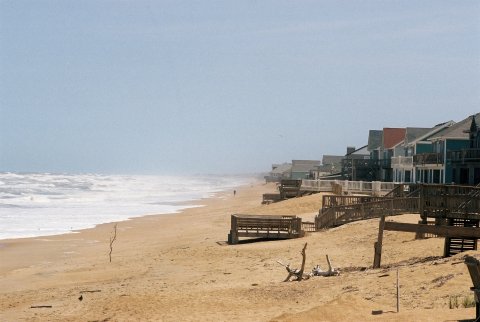
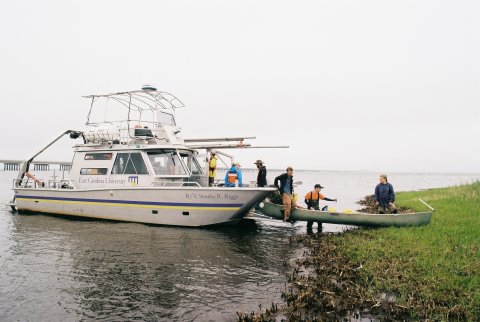



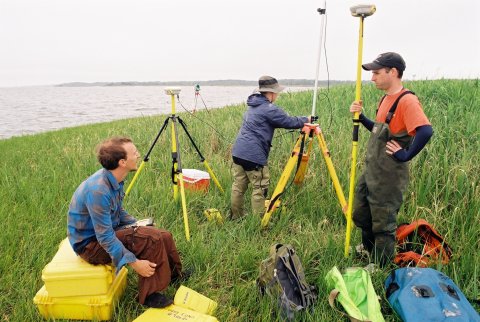
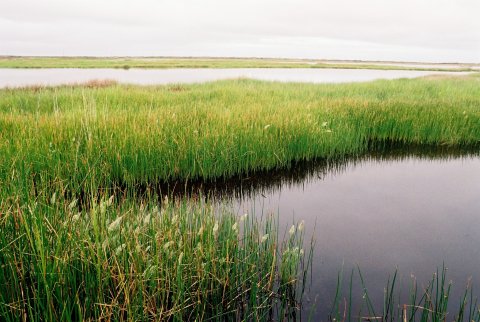

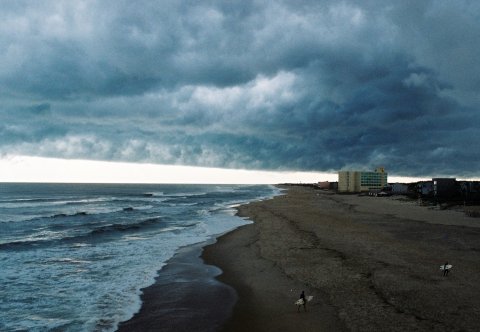
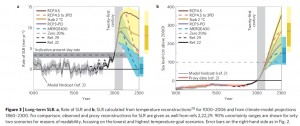
Stefan,
I am wondering, during your stakeholder workshop, if there was discussion about how to handle the inevitable issue of property loss and evacuation. Preceding actual property loss, we should expect insurance rates to rise and become unaffordable (as with earthquake insurance in California), and at some point down the road, property values will plunge, since no one will want to buy a house that will be wiped out by rising seas.
I am wondering how local property owners are looking at this issue? I am also trying to get a handle on what kind of timeline the public reaction will play out on? Will property values degrade 1 year, 10 years, 100 years before the property loss? How will public planning plan for and manage risk?
This is different from earthquakes in California, where people build, knowing that it is a gamble. In NC, people built, not knowing about climate change and sea level rise. As the knowledge becomes commonplace, and property losses assured, how does the property owner handle the loss? As with the tobacco industry, do Big Oil/Coal and the carbon emitting industries get taken to court by the effected states and a “Master Settlement Agreement” – similar to what happened in the states versus Big Tobacco – get implemented to compensate for loss?
“How will public planning plan for and manage risk?”
Planning? PLANNING??
Where do you think you are, North Korea?!
> banks are naturally moving landward
That’s what I recall from Pilkey’s book “The Beaches Are Moving” — someone else in an earlier thread recently said they’re migrating seaward. Is that being argued?
[Response:See paper linked with that statement, Stefan ]
Further to Jay’s remarks about insurance there are some problems with the way insurance firms in the US are dealing with climate change. These problems have to do with liability for damages caused by climate change induced by polluters. In order to make a consistent and robust case for not bearing responsibility for customer damage liabilities insurance firms have to stopper their ears to other facts.
It seems likely this cognitive dissonance in the insurance community will cause increasing tensions, particularly when it comes to reinsurance.
See article here for explanations.
Far out.
Thanks.
Stefan:
Thank you, thank you, for the pictures! I think you guys should do this more often.
Steve
Interesting! We’re heading off to the outer banks for a family vacation in a couple of weeks. I plan to teach the kids a little about sea level rise while we’re there, so this is very timely. We plan to visit the breach at Hatteras that hurricane Irene cut last summer. The daily mail has some great photos:
http://www.dailymail.co.uk/news/article-2032221/Hurricane-Irene-Before-images-effects-storms-fury.html
(probably the only time I’ll ever link approvingly to the Mail).
So what else should we look out for while we’re there? Are there opportunities for educating tourists (and residents) about sea level rise with some hands on fieldwork?
Local councils in Victoria Australia were complaining that the 80cm SLR restrictions by 2100 was hampering development, The Victorian Parliament solved the problem by redefining SLR to 20cm by 2040 for development application compliance. Now those same councils are demanding indemnity from future liability associated with SLR.
Not only in NC
http://www.theage.com.au/victoria/state-eases-sea-level-regulations-20120605-1zu9i.html
.
I foot per 20 years does not seem scary. Is a that linear increase, or exponential?
> Now those same councils are demanding indemnity
“… reminds me of the man who murdered both his parents, and then when sentence was about to be pronounced pleaded for mercy on the grounds that he was an orphan” — A. Lincoln
RCP 4.5? Optimist.
1 foot per 20 years does not seem scary. Is a that linear increase, or exponential?
When your house is underwater does it matter what the graph looked like?
Things below +10ft in New York, New York w/”only” 5′ increase in sea level:
Population 232,589
Homes 100,970
Source.
> does not seem scary
It’s not the longterm average that floods you.
Look at the slope in those pictures, or look up a topo map.
A foot vertical is much more horizontal.
A hurricane’s onshore winds push water into the Sound (behind the Banks) through channels and sometimes overland.
After the eye of the storm passes, the wind direction reverses and begins pushing that water, plus whatever rainfall is coming down the rivers, back out through the “inlet” channels (including newly cut ones) toward the ocean.
Take a look: https://docs.google.com/viewer?pid=bl&srcid=ADGEEShXLJHCbGB_30ZAbD7O0Fd5ki2FP0Y7pFV1LVyNe-Fq0uNqxkaVR3ADPFiQQkpOvldTB84Wx_oLv4W3C5fVfz9yom9gKmbCFlW5vbhzfaDHupkLhvYgcdOx7WiqnTyTk_8sD96l&q=cache%3AlgKaZ3n_8FwJ%3Awww.ecu.edu%2Ficsp%2FICSP%2FReports_files%2FPastPresentAndFutureInletsDec2008.pdf%20&docid=610e8549247eb6d419a5d9888810d86f&a=bi&pagenumber=6&w=800
from
http://www.ecu.edu/icsp/ICSP/Reports_files/PastPresentAndFutureInletsDec2008.pdf
Storm surge adds to or subtracts from the tidal variation, depending on the timing. A large surge that comes inland may be held there by a subsequent high tide, for example, before pushing back out.
Back before property boundaries and overcrowding, during really high water, houses floated between the sea-side and Sound-side dunes, and wherever they ended up, people put them back on new foundations and there they stayed.
(I spent quite a few childhood summers at Beaufort, as a faculty brat around Duke’s Marine Lab, long ago)
Aside: when looking at the satellite imagery, you’ll notice another interesting feature in the area, one answer to “hey, what else could go wrong?”
https://www.google.com/search?q=carolina+bays
https://www.google.com/search?q=carolina+bays&hl=en&prmd=imvnso&tbm=isch&tbo=u&source=univ&sa=X&ei=R7bnT_HIBers2gX_p4naCQ&ved=0CGoQsAQ&biw=1332&bih=850&sei=b7bnT5iYKOiK2gWpxeWLDQ
Steve Easterbrook @7 — Check out the Cape Hatteras light. Regarding SLR, inspect the base of the tower.
Actually I suppose it would be better to use North Carolina as an example of what “just” 5′ of change does.
North Carolina.
Note the distribution of years. No wonder developers are nervous about this.
Insurers will want to protect themselves by making sure that the real estate industry is identified for permitting and/or encouraging people to place their homes in harm’s way. And it’s hard not to wonder how the real estate industry lobbied as North Carolina’s legislators worked up their preposterous law.
Hank Roberts (#3) mentions Orrin Pilkey’s book “The Beaches Are Moving”, which provides an opportunity to plug the Pilkey’s (father & son) “Global Climate Change: A Primer”. Beautifully written, illustrated and produced, it makes a great gift for those ‘unconvinced’ among your friends or family. And a good resource for the rest of us.
The Climate Central maps above refer to the combined effects of surge and sea level change. This video from today shows what planners will increasingly face and why it’s sheer folly to pretend that everything’s going to be ok for coastal development.
The scenes from that video, happening more often and with more severity. It’s not complicated but if you’re a coastal developer acknowledging the problem is an existential threat, too early.
More Stefan and Crew in the Guardian: Scientists warn US east coast over accelerated sea level rise
This is a very good finding that will enable the American government to come to reality that climate change is real and no matter wherever you are , the wrath of the catastrophe will get you.
Its time now you accelerated funding to our southern NGOs to reduce the global warming as we go green and plant trees to avert the rate of climate change.
Edward Paul MUnaaba
Executive Director
Africa Partnership on Climate Change Coalition
http://www.envaya.org/apccc
I’ve just found Arctic regions much more vulnerable to change than thought.
Is it relevant to this thread?
It would be (very) interesting to know whether a salt marsh can accumulate at greater than a millimetre a year. Are there any examples where the subsidence rate is faster, but a marsh is still keeping pace?
“Planning? PLANNING??
Where do you think you are, North Korea?!”
If Freddie and Fannie stopped taking loans without flood (and everything else) coverage, then the market would lead the way, methinks.
As the world’s wealthy increase in numbers while coastlines decline, it could evolve into a sort of rental mentality which still supports high prices. Like a 20 year lease. Climate science improves, the insurance industry will listen, and folks will pretty much know how their insurance premiums will rise decades in advance. Just one of the many costs of living large.
And don’t forget the winners. Pick some land with the proper slope and elevation and you could have some pretty stable shoreline in a hundred years. And with all that shallow water in front of you, hurricanes are less of an issue. Nice gift for the grandchildren’s grandchildren.
It’s probably worth reminding the governments of North Carolina, Virginia and Victoria (and any other states named for English monarchs) that commanding the tides didn’t work last time an English monarch tried it:
https://en.wikipedia.org/wiki/Cnut_the_Great#Ruler_of_the_waves
(but at least he didn’t even pretend to think it’d make any difference).
Although the geology is a little different to North Carolina’s, sections of the East Anglian coast face similar problems.
The rate at which this is occuring is not thought to have changed signficantly in at least 2,000 years – about a metre per year.
But extreme weather events can lead to serious damage virtually overnight, as happened at Dunwich.
Once an important commercial port, the harbour and 400 homes were swept into the sea during storms in the 13th-14th centuries, reducing it to a small village.
Rising sea levels and more energetic waves seem to be making the problems of coastal erosion worse.
Two of the most obvious locations where this is happening are at Happisburgh in Norfolk (pronounced “Hazeburrer” by locals) and near to Southwold in Suffolk.
At both places, houses near to the clifftops are in danger of falling into the sea
A survey done at Happisburgh between 2001-6 using LiDar, found that there were two main causes:-
1- Wintertime erosion caused by groundwater, coupled with increased seasonal storminess, causing small-scale, frequent, shallow landsliding of the soft sandstone cliffs.
2- Summertime Wave, accompanied by landsliding.
http://www.bgs.ac.uk/landslides/happisburgh.html
See this video clip for the effect on the population:-
“Living with coastal erosion in Happisburgh, East Anglia” Duration: 3:03
http://www.bbc.co.uk/learningzone/clips/living-with-coastal-erosion-in-happisburgh-east-anglia-pt-2-2/7364.html
Near Southwold, Peter Boggis, the “King Cnut of East Anglia” has decided to take matters into his own hands.
For nearly a decade, the retired engineer has been building an earth bank at the base of the natural cliff to provide an extra barrier against the North Sea.
So far he’s deposited at least 250,000 tonnes of compacted clay soil from building sites at the base of the cliff.
The last time I looked, his house was still there, but I get the feeling that he’s fighting a losing battle.
http://www.bbc.co.uk/suffolk/content/articles/2007/02/22/video_nation_weatherwatch1_video_feature.shtml
priankoff: But extreme weather events can lead to serious damage virtually overnight, as happened at Dunwich.
If it’s the town I’m thinking of Dunwich was also a good example of our short chronological perspective and rapid growth on unstable coastlines. The town and port were developed relatively quickly in a location that with a longer perspective would have been plainly wrong.
Now we have that perspective but it’s an open question if we’ll use it.
On the position of insurers, you need to remember that the industry writes property coverage a year at a time. What will happen 20 years from now is, by definition, irrelevant to what the carrier should charge for risk in 2012.
Nor will a reinsurer/insurer conflict actually happen. If reinsurers fundamentally change their view of property risk (meaning they raise rates or restrict the availability of coverage) the resulting constriction of supply will force up rates. That is, the relationship between reinsurers and insurers is self-regulating and will find stability.
Aaaah, the old “We don’t believe you because we were heading into an Ice Age in the 1970’s, and well, anyway Daddy PROMISED ME that we wuz’uh just gonna make like, ‘It’s gonna be da 1950’s 4-EVER!”, type scenario,’ eh what, Old Chaps, Komrades, Fellow Global Conspirators for Imposition of Common Sense upon the “Seething Masses (of Stoopidity)”?
It is indeed a fact that, in my Oceanography Classes, in the early ’80’s, it was indeed assumed that the Milancovich Cycles were pointing us towaards another Ice Age….though, in my view,that’s simply all the more reason to be worried about Global Warming; as it IS occuring, and IF we were headed ‘into another Ice Age’, but ‘things are getting warmer, and the Planets Ice Sheets and Glaciers, EVERYWHERE, are ALL MELTING instead’, then that probably means that Global Warming is not just “Real”, it’s “So Freaking R-E-A-L!!!!” that it’s REVERSED THE ‘HEADED FOR ANOTHER ICE AGE’ OVERALL TENDENCY OF THE GLOBAL CLIMATE!!!!
Duh!
We Could Fix This, NC-20s’ o’ da wurld – We, The People, you see; It’s JUST the kind of Commie-wealth, Pinkobama Political Philosophy that the “Peoples Republic” of America needs!
Why, in 2005 “The Peoples Republics” of China and The Untied State of America were both tied at about 500 Mwh of PV Panel production per annum; by 2001, “The Peoples Republic” of China was making 11,000 Mwh, and “The ‘We, The Peoples’ Republic of The United States of America” was making 650 Mwh!
But, Oooooh NOOOO, Dr. Chu shouldn’t have given any money to SOLYNDRA, should he have?
No, he should have wasted it on generating some Realpolitik that doesn’t SCARE THEM – just like NC-20 has wasted it’s ‘members’ donations and dues!
> weakening of the Atlantic overturning circulation
I’m confused. This was a hot topic back in 2005, but starting around 2007-2011 there was a constant buzz that no, in fact the circulation is not slowing. Google for links, I think NASA used satellites to confirm there was no slowdown, indeed a slight speed up. Very confusing.
“Of course, global sea-level rise has already accelerated in the course of global warming…”
Has accelerated in the past, yes, but does not show any sign of accelerating at present (i.e. over the last 20 years). http://sealevel.colorado.edu/
Their sea-level data from 1993-present show an average rising trend of +3.14mm/yr and deceleration of -0.057mm/yr^2
(Data available at http://sealevel.colorado.edu/files/2012_rel2/sl_ns_global.txt)
And, no, I didn’t cherry-pick a start date… I’ve used all the data they report.
Perhaps, IMO, the most drastic aspect of Global Warming is the increasing acidification of the ocean, which is almost always omitted from discussions related to the ocean and sealevel rise. My question: Is there any evidence found witin core samples of past increasing ocean acidification in connection to past Global Warming events? It seems all the focus is on what’s going to happen ashore, with little thought given to what a plankton dieoff will cause.
Expected sea level rise is based on models that have dramatically understated loss of Arctic sea ice in the last few years, and explicitly do not include ice dynamics.
When the Arctic sea ice has melted, the heat fluxes that had gone into melting sea ice will go into melting the GIS. In addition, feedbacks from an ice free sea surface will supply additional heat to the Arctic environment, and the Greenland Ice Sheet will melt rapidly, and big blocks of ice will slide into the sea without melting.
I do not see Climate Science offering a prudent and rational estimate of expected sea level rise. The scenarios offered by Climate Science are comforting stories for children. The above is looking back at a period of stable climate. It says nothing useful about how sea level will change when the GIS is the primary heat sink in the Arctic. However, given these season’s melt, that may be sooner rather than later.
We cannot use past sea level rises as a guide for expected sea level rise because current forcing is greater than past forcing. If current forcing is ten times faster than it was in the past then we have to consider that sea level rise events may be ten times larger than they were in the past. However, climate is a non-linear system so that in fact, a larger forcing may bring a very much larger rate of sea level rise.
http://sealevel.colorado.edu/content/map-sea-level-trends
What’s the reason to think a 19-year span could be likely sufficient to detect a change in rate?
Aaron: I do not see Climate Science offering a prudent and rational estimate of expected sea level rise.
Presuming that we don’t have a noise problem causing model/observation divergence then models need a plausible means of accounting for the divergence; anything less would be definitively irrational and not science.
ozajh @23:
Some of the marsh grasses can cope with sediment accumulation of centimetres per year. As an example, Parkgate in the Dee Estuary (UK) was a popular beach resort in the 1930s but by the 1950s the beach had turned into a salt marsh for a considerable distance from the old promenade.
I gather that in many places, however, there is insufficient sediment arriving for there to be rapid accumulation. Also, the resulting marsh would likely have a very different species composition from the original.
Does anyone know how house prices are responding at Happisburgh? Those that are on the edge of the cliff are no doubt unsellable but what about houses, say, half a kilometre back from the sea?
“And it’s hard not to wonder how the real estate industry lobbied as North Carolina’s legislators worked up their preposterous law.”
NC House Bill 819 was introduced by Pat McElraft, who lists her occupations as “Technical Sales Representative – Microbiology Products Company and Real Estate Broker”, and she lives on Emerald Isle, an upscale development barrier island – no lobbyists needed.
jaykimball @ 24 Jun 2012 at 1:11 PM says “Preceding actual property loss, we should expect insurance rates to rise and become unaffordable (as with earthquake insurance in California)…” Don’t worry, Ms. McElrath has introduced more legislation that addresses this problem, HB820 –
“SECTION 2. Purpose. – The Commission shall study the following:
(1) The feasibility and advisability of replacing the North Carolina Insurance Underwriting Association and the North Carolina Joint Underwriting Association with a statewide catastrophic fund which pools the risks to North Carolina policy holders from all types of natural disasters.
(2) Whether coastal insurance rates on policies ceded to the North Carolina Insurance Underwriting Association, the composition of the Association’s Board of Directors, and the Association’s plan of operations are efficient, economical, fair, and nondiscriminatory in protecting the interests of beach and coastal areas of the State, compared to other coastal states.
(3) Whether the data and methodologies used by the North Carolina Insurance Underwriting Association in estimating probable maximum loss accurately model insurable risks for property located in the beach and coastal areas of the State.
(4) The feasibility and advisability of offering coastal and beach area property owners the option of self‑insuring by declining wind and hail coverage in situations where no third party has an insurable interest in the property.
(5) The adequacy of accounting and oversight of the North Carolina Insurance Underwriting Association’s accumulated surplus.
(6) Whether the mitigation credits provided by the North Carolina Insurance Underwriting Association pursuant to G.S. 58‑45‑45(e) are fair and nondiscriminatory and whether the schedule of credits, when compared to the cost of mitigation measures provides adequate incentive for beach and coastal area property owners to invest in such measures.”
Or at least addresses the problem insofar as it adversely affects profitable beach development – for the rest of us in the state who will end up subsidizing pooled insurance for coastal areas at risk, not so much.
Richard Simons @35,
Thank you for that response. I can see that the amount of sediment entering (or leaving via erosion, for that matter) could easily be a dominant factor.
However, I was actually wondering how much material can be generated by a marsh itself. If it’s fast enough, one COULD imagine a protective mechanism where a (perhaps porous-but-not-too-porous) retaining wall gets put in at an appropriate level (which may of course be below mean sea level). The marsh would then grow behind this wall, with the top of the wall being raised up at intervals in tune with sea level rise. This would also act as a carbon sink.
Better not to have the warming and sea level rise occur in the first place, of course.
Great story. We don’t have such interesting field trips in computer science.
Is the NC state legislature also planning to legislate the value of pi?
I seem to recall a figure of about 100x the horizontal encroachment vs. sea level rise, e.g., 1m sea level rise means the coastline retreats 100m inland. Obviously at best this is a rule of thumb and would vary highly from place to place, but this does give some indication in general terms of what a given sea level rise implies.
@32 Aaron Lewis: If I read the paper by Schaeffer et al correctly the Copenhagen reference (BAU?) scenario could lead to about 6.5 meters of SLR by 2300, excluding the risk of ‘nonlinear, dynamical responses from the ice sheets’.
They also say: ‘One of the largest uncertainties at present is the response of the Greenland and Antarctic ice sheets, where process-based models do not capture the full response so far observed, nor the timescales of response seen in the paleorecord.’
So it seems the authors of the paper largely agree with you. If not, I hope they will comment.
Russ,
Historically, sea level rise has increased during warming periods (compare the rise in the 1925-1945 period with those before and after).
http://www.columbia.edu/~mhs119/SeaLevel/SL.1870-2012.pdf
Sea level has also risen during the cooling periods, just not as much. The increased rate of rise from 1985-2005 is similar in magnitude to the previous period (within measurement uncertainty). Based on the available data, it would be perfectly acceptable to state that sea level rise accelerated in the past 20 years, and you are correct in saying that the sea level rise is currently not continuing to accelerate. Based on historical data and trends, it seems reasonable to conclude that sea level will continue to rise somewhere between 18 and 27 cm by 2100. A return to the lower rate of rise in the late 19th century seems highly unlikey, unless a similar cooling trend commences.
Lennart van der Linde #40 says
Eh, where did you get 6.5 meters from? Visually extrapolating a graph? That’s pretty bold, given the uncertainties involved (also discussed in the paper), which increase with both temperature and time elapsed, and which could go in either direction. And decimetric precision?
…but yes, 6.5 m could happen. As could some other value in a pretty broad range…
sea level rise is currently not continuing to accelerate.
Can you tell me how you managed to measure the instantaneous acceleration of sea level rise? Yes, that is a trick question. Thanks in advance.
“Can you tell me how you managed to measure the instantaneous acceleration of sea level rise?”
I didn’t measure the instantaneous acceleration. I measured the average acceleration over the the last 19 years. In case you want to try it yourself, here’s how:
1. I downloaded the data as text from here: http://sealevel.colorado.edu/files/2012_rel2/sl_ns_global.txt
2. I copied the text data into an excel spreadsheet and ran the “Text to Columns” functions.
3. I plotted the data in a scatter chart with the year values on the x-axis and the observed sea-level values on the y-axis.
4. Finally, I plotted a 2nd order polynomial trend line which showed acceleration (or rather, deceleration) of -0.057 mm/yr^2.
And so I concluded that over the last 19 years, sea level rise has not accelerated.
prianikoff (25 Jun 2012 at 5:45 AM) writes:
Although the geology is a little different to North Carolina’s, sections of the East Anglian coast face similar problems.
The rate at which this is occuring is not thought to have changed signficantly in at least 2,000 years – about a metre per year.
Now that would be serious sea level rise. 2000 meters in 2000 years!
Question for Stefan
The Sallenger et al. paper in Nature Climate Change says
“Mean Northeast Hotspot SLRD (sea level rise differnece) is a factor of 3 to 4 larger than global SLRD. For the 60-yr window, the global SLRD during 1950 to 2009 is 0:59 mm/yr(u sing reconstructed time series ref-14), compared with NEH SLRD of 1:97 mm/yr.” Church and White (2011 – Surveys in Geophysics) say: “We estimate the rise in global average sea level from satellite altimeter data for 1993–2009 and from coastal and island sea-level measurements from 1880 to 2009. For 1993–2009 and after correcting for glacial isostatic adjustment, the estimated rate of rise is 3.2 ± 0.4 mm year-1 from the satellite data and 2.8 ± 0.8 mm year-1 from the in situ data.”
Can you reconcile these differnt global rates? The global estimates seem pretty far apart, unless I am trying to compare apples and oranges (increases versus rates of increases).
Ned @45: I don’t think he was talking about sea level rise…
Russ R., why do you believe that data set has enough data points for a trend estimate to be made? Significance is calculated and you didn’t do that yet.
Grumbine on this is helpful: http://moregrumbinescience.blogspot.com/2009/01/results-on-deciding-trends.html
And so I concluded that over the last 19 years, sea level rise has not accelerated.
I was more interested in the concept of instantaneous acceleration. Sorry to be such a jerk.
This may be helpful (paywalled, all I see is the abstract; it hasn’t been cited by anyone yet).
http://www.sciencedirect.com/science/article/pii/S0273117710007751
http://dx.doi.org/10.1016/j.asr.2010.12.003
Advances in Space Research
Volume 47, Issue 7, 1 April 2011, Pages 1248–1255
Minimum time span of TOPEX/Poseidon, Jason-1 and Jason-2 global altimeter data to detect a significant trend and acceleration in sealevel change
“The present study aims to estimate a minimum time span of the global mean sea level time series (from TOPEX/Poseidon, Jason-1 and Jason-2 satellite altimetry) which is sufficient to detect a statistically meaningful trend in global sea level variation. In addition, the objective of this paper is also to seek a minimum time span required to detect a significant acceleration in sea level change.
Detecting a trend is based upon the Cox–Stuart statistical test. In order to make the analysis representative a stepwise procedure is proposed…. Detecting an acceleration is based on the same procedure, however, applied to the differenced global mean sea level time series.
We infer that the trend in the global mean sea level time series (January 1993–April 2010) corrected for the global isostatic adjustment can be detected for all significance levels from the set S with the probability close to 1 after 110 satellite cycles (approximately 2.99 years). The corresponding estimate based on the data without correcting for the global isostatic adjustment is equal to 114 satellite cycles (approximately 3.09 years). Over the majority of the study period it is impossible to detect any acceleration in sea level rise. However, for the time spans of approximately 400 and 500 satellite cycles an acceleration may be detected with probability of approximately 0.4. These specific time spans correspond to the periods with reduced rates of sea level change.”
[Response:Statistical significance of a trend or acceleration calculation, given the noise in the data, is obviously one minimum condition for interpreting these numbers. More interesting though is the question on what time scale you might see a physically meaningful acceleration due to global warming (rather than e.g. the effects natural decadal variability that is unrelated to global warming). Based on our analysis (see Rahmstorf et al., Climate Dynamics 2011) the altimeter data set is clearly too short to give any meaningful acceleration in this sense. stefan